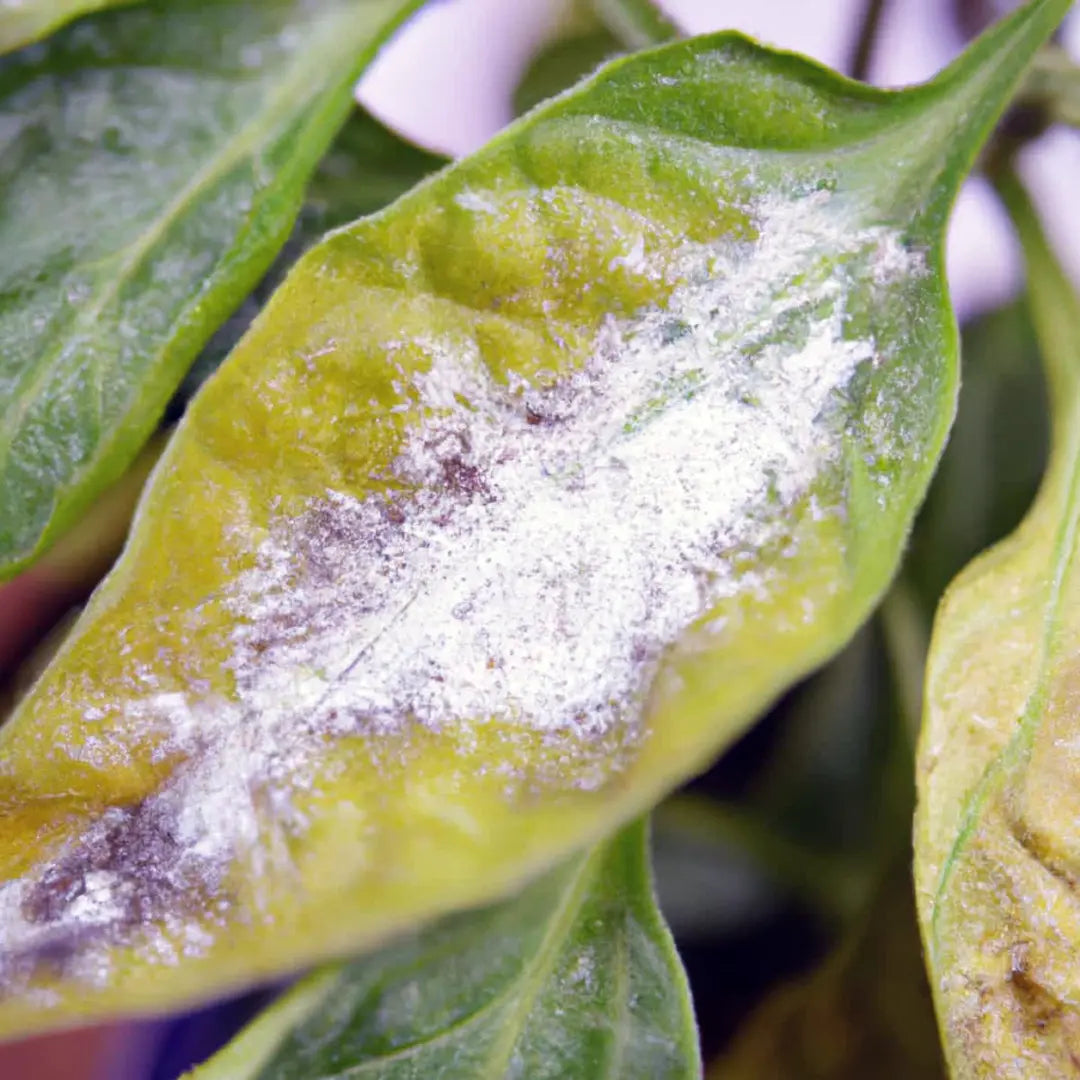
Powdery Mildew
Powdery mildew is a widespread and damaging fungal disease that affects a variety of plants, including chilli plants. It's essential to identify, understand, and manage this disease to keep your chilli plants healthy and productive. In this article, we'll discuss the identification, symptoms, prevention, and management of powdery mildew on chilli plants, particularly for growers in New Zealand.
Collapsible content
Identification
Powdery mildew is caused by a group of fungi, with the most common species affecting chilli plants being Oidium capsici and Leveillula taurica. These fungi thrive in warm, humid conditions and are especially problematic in late spring and summer in New Zealand.
The disease can be identified by its characteristic white, powdery substance that appears on the surface of leaves, stems, and even fruits. It often starts as small, white, circular patches that expand and merge as the infection progresses. As the disease develops, the affected areas may turn yellow, wither, and die.
It's essential to identify powdery mildew early to minimise the spread of the disease and maximise the effectiveness of any control measures. Regularly inspect your chilli plants, paying close attention to the undersides of leaves, as the fungus often begins its attack there. If you notice any suspicious white patches or a general decline in your plants' health, take immediate action to manage the problem.
Symptoms
The symptoms of powdery mildew on chilli plants can vary depending on the severity of the infection and the specific fungal species involved. However, there are some common symptoms that you can watch for:
- Powdery white patches: The most obvious sign of powdery mildew is the appearance of white, powdery patches on leaves, stems, and fruits. These patches can be easily rubbed off, revealing the fungal spores.
- Leaf distortion: Infected leaves may become distorted, curled, or twisted as the disease progresses. This can be particularly damaging to the photosynthetic capacity of the plant, leading to reduced growth and yield.
- Chlorosis and necrosis: As the fungal infection spreads, affected leaves may turn yellow (chlorosis) and eventually brown or black (necrosis) as the plant tissue dies. This can lead to premature leaf drop and further reduction in plant vigour.
- Reduced fruit production: Powdery mildew can negatively impact fruit production, as infected flowers may fail to set fruit or produce smaller, misshapen fruits. The fruits themselves may also become infected, leading to poor quality and reduced marketability.
Prevention and Management
Preventing and managing powdery mildew on chilli plants requires a combination of good cultural practices, resistant varieties, and targeted fungicide applications.
- Choose resistant varieties: Some chilli varieties are more resistant to powdery mildew than others. When selecting seeds for planting, look for varieties that have been bred for resistance or tolerance to this disease.
- Provide adequate spacing: Overcrowding can create a humid microclimate that favours the development of powdery mildew. Ensure that your chilli plants have enough space for good air circulation, which can help reduce the humidity around the plant.
- Water wisely: Water your chilli plants in the morning so that the foliage can dry quickly. Avoid overhead watering, as this can promote the spread of fungal spores.
- Maintain good hygiene: Regularly remove any infected plant material, including fallen leaves and debris. This can help prevent the build-up of fungal spores in your growing area.
- Monitor and protect: Keep a close eye on your plants for any signs of powdery mildew infection. The earlier you identify the problem, the more effective your control measures will be.
- Apply fungicides: For severe infestations, consider using targeted fungicides to control powdery mildew. Always follow the manufacturer's instructions and apply fungicides in the early stages of infection to maximise their effectiveness. In New Zealand, some of the commonly used fungicides for powdery mildew control include sulfur-based products, potassium bicarbonate, and biological control agents like Bacillus subtilis.
- Implement crop rotation: To reduce the risk of powdery mildew infections, practice crop rotation by planting non-host plants in the affected area for at least one growing season. This can help to break the disease cycle and reduce the build-up of fungal spores in the soil.
- Encourage beneficial insects: Some insects, such as ladybirds and lacewings, feed on powdery mildew fungal spores. Encourage these beneficial insects in your garden by planting a variety of flowering plants that provide them with nectar and pollen.
- Use physical barriers: In some cases, installing physical barriers like shade cloth or windbreaks can help reduce the spread of powdery mildew spores by limiting their movement within the growing area.
By implementing these prevention and management strategies, you can protect your chilli plants from the harmful effects of powdery mildew and enjoy a healthy, bountiful harvest. Remember that early identification and intervention are key to controlling this persistent fungal disease. With proper care and attention, your chilli plants can thrive despite the challenges presented by powdery mildew.
